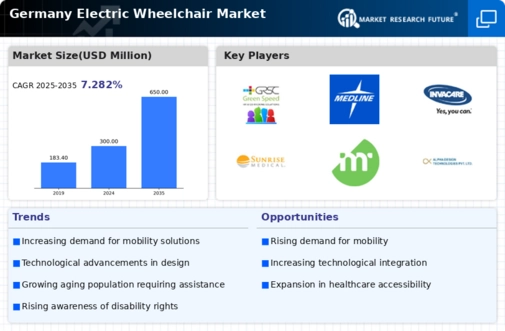Rising Demand for Mobility Solutions
The electric wheelchair market in Germany experiences a notable increase in demand for mobility solutions, driven by a growing awareness of the importance of independence among individuals with mobility impairments. As the population ages, the need for assistive devices becomes more pronounced. Recent data indicates that approximately 15% of the German population is over 65 years old, a demographic that often requires mobility aids. This trend suggests that the electric wheelchair market will likely expand as more individuals seek to maintain their autonomy and quality of life. Furthermore, advancements in electric wheelchair technology, such as improved battery life and enhanced maneuverability, contribute to this rising demand, making these devices more appealing to consumers. The electric wheelchair market is thus positioned for growth as it adapts to the evolving needs of its user base.
Growing Awareness of Disability Rights
The electric wheelchair market in Germany is positively impacted by the growing awareness of disability rights and inclusivity. Advocacy groups and organizations are increasingly promoting the rights of individuals with disabilities, leading to a societal shift towards greater acceptance and support for mobility aids. This cultural change encourages more individuals to seek electric wheelchairs as a means of enhancing their mobility and independence. Furthermore, public awareness campaigns are highlighting the importance of accessible infrastructure, which in turn drives demand for electric wheelchairs. The electric wheelchair market is thus likely to benefit from this heightened awareness, as more individuals recognize their right to mobility and seek out solutions that facilitate their active participation in society.
Economic Factors and Insurance Coverage
Economic factors play a crucial role in shaping the electric wheelchair market in Germany, particularly regarding insurance coverage and reimbursement policies. Many individuals rely on health insurance to cover the costs associated with purchasing electric wheelchairs. Recent changes in insurance policies have expanded coverage for mobility aids, making them more accessible to a broader segment of the population. This shift is particularly relevant as the average cost of electric wheelchairs can range from €1,500 to €5,000, depending on the features and specifications. As insurance companies recognize the long-term benefits of providing coverage for mobility aids, the electric wheelchair market is likely to experience growth. Increased affordability through insurance reimbursement may encourage more individuals to invest in electric wheelchairs, thereby enhancing their quality of life.
Technological Innovations and Customization
Technological innovations are reshaping the electric wheelchair market in Germany, leading to enhanced functionality and user experience. Manufacturers are increasingly investing in research and development to create electric wheelchairs that offer advanced features such as smart technology integration, customizable seating, and improved navigation systems. For instance, the introduction of app-controlled electric wheelchairs allows users to adjust settings and monitor battery life conveniently. This focus on customization caters to the diverse needs of users, including those with specific medical conditions or lifestyle preferences. As a result, the electric wheelchair market is likely to see a surge in demand for these innovative products, as consumers seek devices that align with their individual requirements and enhance their mobility experience.
Increased Focus on Health and Rehabilitation
The electric wheelchair market in Germany is significantly influenced by an increased focus on health and rehabilitation. Healthcare professionals and institutions are recognizing the critical role that mobility aids play in the recovery and rehabilitation process for patients with mobility challenges. Studies indicate that using electric wheelchairs can enhance physical health outcomes by promoting mobility and reducing the risk of secondary health issues. As a result, hospitals and rehabilitation centers are increasingly incorporating electric wheelchairs into their patient care protocols. This trend not only supports the electric wheelchair market but also emphasizes the importance of integrating these devices into comprehensive rehabilitation programs. The electric wheelchair market is thus likely to benefit from this heightened awareness and commitment to improving patient mobility and overall health.






















Leave a Comment